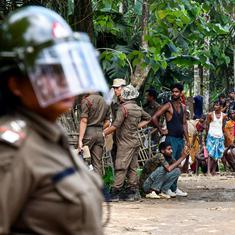There once was a gateway here, one of 13 that allowed entry into the walled city. In the aftermath of the rebellion of 1857 and given the debacle for the British in walled Delhi, the walls of Lahore were razed. Only a few of the 13 gateways survive, pretending to guard entrance into a city that has long been besieged. This particular gateway may have long disappeared but its name survives – Shahalam Gate, the largest wholesale market in Lahore. Some claim it is the largest market in Punjab while the more enthusiastic townsfolk hold it to be the largest wholesale market in all of Asia.
Dominated before 1947 by Hindu traders who formed the backbone of the city’s economic activity, Shahalam Gate market witnessed one of the worst riots of Partition. The entire market, it is said, was burned down. For many prosperous Hindus, whose families had long been associated with Lahore, the city of Lav, the son of Ram, this was the final nail in the coffin, forcing them to conclude their city was no longer safe for them.
In subsequent years, Lahore managed to rise from the ashes of Partition. Perhaps it was easy for this city to do so. Much of the infrastructure had been laid by the colonial state, under which Lahore had become Punjab’s economic, political and cultural centre, and one of British India’s largest cities. After the creation of Pakistan, it became the new country’s largest city, although it was eventually overtaken by Karachi, swelled by a massive influx of refugees from India. But the middle class, the professionals, the artists who had helped raise Lahore to the pinnacle of its grandeur had all left.
It was not long, though, before Lahore reemerged as Pakistan’s cultural, economic and political hub. With writers and artists such as Faiz Ahmed Faiz, Saadat Manto and Nur Jahan making the city their home, it scaled new heights. But in many ways, this Lahore that was emerging was not the Lahore that had been. The Lahore of the colonial era was a multi-religious society where Diwali and Holi were celebrated with as much fanfare as Eid and Basant. It was a city where Hindu and Sikh professors taught Muslim students. It was a city where Muslims visited Hindu temples and Hindus Sufi shrines. It was a city where Hindu and Muslim nationalists had stood together to challenge the might of the colonial state.
The new Lahore was quickly becoming a monolithic society. It was where the fire of anti-Ahmadiyya riots was first ignited in 1953, resulting in the city being put under martial law. While there was dissent and pushback against an overarching uniform culture, perpetuated by a state that was increasingly defining itself through a narrow lens, it was a battle that was eventually lost. The Lahore that would emerge in the following years was a conservative city, eager to align itself with the status quo. Partition had fundamentally altered the nature of the city.

Surviving in the shadow
Yet, despite such fundamental changes, scattered all over Lahore are the remnants of that old city lost to Partition. About a kilometre and half from Shahalam Gate market, for example, is the famous Laxmi Chowk, home to the country’s iconic film industry before the violence of the Zia-ul-Haq era brought the edifice down.
The square is named for Laxmi Building, an architectural marvel that was once a residential complex but of which only the façade survives now. I am told by Hindus who still live in the city that Laxmi Chowk used to host the largest Diwali celebration in Lahore. The building would be lit up by lamps as Muslims, Hindus, Sikhs and Christians, men and women, all gathered to celebrate the return of Ram to Ayodhya. In the new Lahore that was eager, almost desperate, to shed its multi-religious identity, the square was renamed Maulana Zafar Ali Khan Chowk, after a stalwart of the Pakistan Movement. Yet, today, hardly any resident would be able to recall Maulana Zafar Ali Khan Chowk, but everyone would immediately recognise Laxmi Chowk.
It is no different with Krishan Nagar. A suburban housing community established in the 1930s to address the changing architectural sensibilities of Lahore’s educated and named after Lord Krisha, it was once dominated by Hindu professionals. After Partition, as it became home to Muslim refugees from India, it was renamed Islampura. But much like Maulana Zafar Ali Khan Chowk, the name never caught on.
Its not just the Hindu past of the city that suffered with the emergence of the new Lahore, but also its Sikh past. Sikhism has a particular association with the city. It is here that the fourth Sikh Guru Ram Das was born. His son, Guru Arjan Dev, was assassinated here and Lahore was also the capital of the Khalsa Empire of Ranjit Singh. Gradually, with the exodus of Sikhs, the city’s Sikh heritage, the monuments and shared history, began fading out of memory. But sometimes this history becomes simply impossible to ignore. It raises its head occasionally, forcing people of the new Lahore to acknowledge the remains of a Lahore that does not exist anymore.
One such example is Killa Gujjar Singh, a small fort town laid out a little distance from the walled city of Lahore by Gujjar Singh, one of Lahore’s triumvirate of rulers before the rise of Ranjit Singh. Like Laxmi Chowk or Krishan Nagar, Killa Gujjar Singh has resisted attempts to whitewash its past.
Many other remnants of the old Lahore similarly continue to confront and frustrate efforts to ignore the city’s past. Perhaps, as long as the new Lahore exists, the old Lahore will continue to survive in its shadow.
A version of this article first appeared on Dawn.
Haroon Khalid is the author of four books. His latest book is Imagining Lahore: The City That Is, The City That Was.










